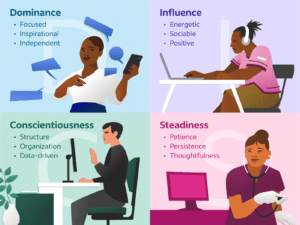
What is the DISC “Dominant” Behavioral Personality Style?
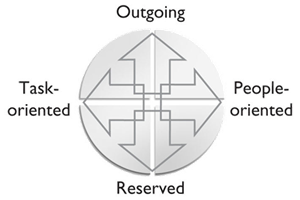
People with the Dominant DISC Behavior Style are Fast-paced and Task-oriented.
They are most interested in the big-picture goals, objectives, tasks, and results. Dominant people prefer to lead than follow, and you tend to find them in leadership and management positions.
Dominant people are self-starters, direct, decisive, and willing to challenge the status quo. They are also highly self-confident, risk-takers, and problem-solvers.
Dominant Personality Type cross-reference
- Keirsey Type – Rationals
- Temperament Type – Choleric
- Animal Type – Lion
- Socio-Communicative Type – Driver
- True Colors – Green
- Color Code – Red
- Personality Compass – North
- Occupational Type – Enterprising
- Learning Type – Activist
- Leadership Type – Dominator
MBTI Personality Types (xNTx) – Intuition and Thinking
Enneagram Types
- Type 1 – The Reformer (ENTJ, INTJ)
- Type 3 – The Achiever (ENTP)
- Type 5 – The Investigator (INTJ, INTP)
- Type 7 – The Enthusiast (ENTP)
- Type 8 – The Challenger (ENTJ)
What is the DISC Behavioral Model?
The DISC Behavioral Model describes an individual’s characteristics, communication preferences, and motivation as observable behaviors.
Recognizing observable behaviors in others can help you communicate more effectively and build stronger relationships, personally and professionally.
Dr. William Marston theorized that people are motivated by two key motivators that direct human behavioral patterns: the Motor Drive (or Pace Driver) and the Compass Drive (or Priority Driver).
The Motor/Pace Driver
If you divide a circle in half horizontally, the upper half represents outgoing or fast-paced people. The lower half represents reserved or slower-paced people.
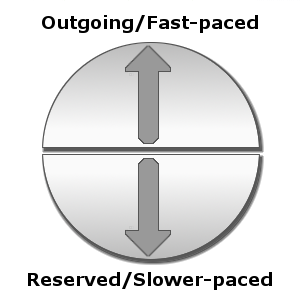
Outgoing people tend to move fast, talk fast, and decide quickly.
Reserved people tend to speak more slowly and softly and generally prefer to consider things carefully and thoroughly before deciding.
Remember that these descriptions of behaviors are tendencies rather than absolutes. Depending on the situation, most people will exhibit a bit of both of these Traits.
Even so, most people will exhibit more of one Trait over the other – even if it is slightly more.
The Compass/Priority Driver
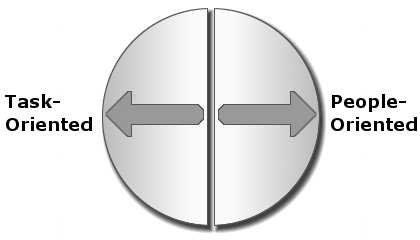
Now, divide the circle vertically. The left half represents task-oriented people, and the right represents people-oriented individuals.
Task-oriented people focus on logic, data, results, and projects.
People-oriented individuals focus on experiences, feelings, relationships, and interactions with others.
The Four DISC Behavioral Styles
When you combine the drawings for the Motor and Compass drives, you get the circle of expected behaviors and perspectives divided into four quadrants.

The DISC circle represents the full graphical description of what is commonly referred to as The DISC Model of Human Behavior.
Each quadrant of the DISC circle has descriptive words attached to it.
These descriptive words attempt to capture the typical behavior traits or tendencies people exhibit with the combination of motor and compass drives corresponding to that quadrant.
They are often called a behavioral type or style to make discussing the quadrants easier.
While using the phrase “personality type” with this model is not strictly or technically accurate from a clinical psychology standpoint, it is often used in everyday conversation.
So, the term Behavioral Style is preferred because it more accurately fits the model and its theory.
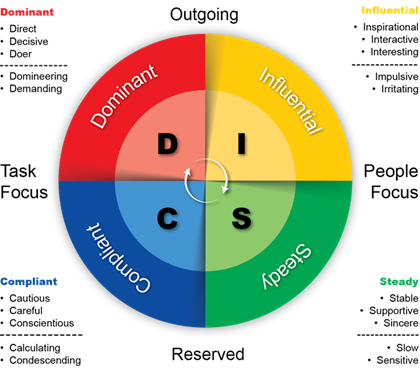
Learn more about the DISC Behavioral Personality Styles.
Personality Temperaments, Traits, and Types
Personality Temperaments, Personality Traits, and Personality Types are used in Psychology to discuss a person’s Personality, a collection of Emotions, Perceptions, and Actions that interact with each other, regulate themselves, and shape a dynamic system that forms a person’s Behavioral Patterns.
Your inherited traits (your personality Temperance) and acquired traits (such as education, socialization, and other various pressures and aspects) form your Personality.
A Personality Type identifies a specific collection of Traits, both learned and natural, that comprise a broad, general Personality Classification—a way of labeling a collection of traits and behaviors.
A Personality Trait remains consistent and stable over time, which means you exhibit the same pattern across different situations and throughout your life.
Three criteria characterize Personality Traits: (1) consistency, (2) stability, and (3) individual differences. For example, if you are talkative at home, you also tend to be talkative at work. And if you were talkative at age 20, you would still be chatty at age 40.
Personality Temperament is your “Naturally Intuitive” biological Trait. These Traits are partly inherited from your genes and partially determined by your brainstem, which doesn’t change throughout your life. These are Natural Traits regarded as innate or inborn and not learned.
Your Personality Temperament is formed as an infant and is hard to modify, manipulate, or change because it is genetic. In some way or another, your inherited behavioral tendency will always be there.
Personality Traits are quantitative differences between people, and Personality Types are qualitative differences between people. The most crucial difference between the Trait Theory and the Type Theory is that the Type Theory views people’s characteristics as discrete categories. In contrast, the Trait Theory views these characteristics as a continuum.
For example, while a Type Theorist would claim that introverts and extraverts are two types of people, a Trait Theorist claims that extraversion is a gradient, and individuals can fall somewhere in the middle.
Your Temperaments, along with acquired Traits, form your Personality.
Traits
- Independent
- Ambitious
- Innovative
- Decisive
- Determined
- Competitive
Motivation
- New challenges and solving problems.
- They want the authority to take risks and make decisions.
- They like to be shown appreciation for their accomplishments.
Dominant people are highly motivated by new challenges and set and achieve goals that produce physical, trackable, or tangible results.
They are motivated by power and authority to take risks and make decisions.
Annoyances
- Inefficiency
- Indecisiveness
- Laziness.
- Lack of – discipline, plan, purpose, direction, authority, and control.
Under pressure
- Dictatorial
- Domineering
- Demanding
- Angry
- Intense
- Forceful
- Direct
- Bossy
Weaknesses
Dominate people tend to overstep authority and prefer to be in charge. As a result, they can be argumentative and not listen to others’ reasoning.
They tend to dislike repetition and routine and may ignore the details an
Team Value
They value time frames greatly and are interested in achieving tangible results.
They are bottom-line organizers who can lead an entire group in one direction.
- They welcome challenges without fear and can overcome obstacles.
- They are innovative in getting results.
- They can see the big picture and maintain focus on goals.
- They can handle multiple projects and function well with heavy workloads.
- They provide direction and leadership and push the group toward decisions.
- They are willing to speak out and accept risks.
- They are also generally optimistic, self-reliant, specific, and direct.
Ideal Environment
Dominate people like to focus on the future and the big picture, prefer non-routine, challenging tasks and activities, and enjoy being in charge.
They want the freedom to make decisions, crave freedom from controls, supervision, and details, and want space from routine and mundane tasks.
Dominate people appreciate receiving verbal recognition from others as well as rewards.
Leadership Style
They tend to take a hierarchal or “autocratic” approach with other people.
- Active, task-oriented, and likes directing groups to accomplish complex tasks.
- They don’t take “no” for an answer.
- They tend to plan and push forward, challenging others to follow.
- They don’t like sitting still and waiting for things to happen.
- They like to make things happen.
- They motivate and mobilize people to accomplish the task.
- They like long-range planning with specific short-term goals involving many people moving forward together.
Follower Traits
- Respect strong leaders.
- They want to be part of a winning team.
- Follow with power and authority in mind.
- Wonder, “Will this action make me more respected and get the job done?”
- Need choices, rather than “get in or get out” ultimatums.
- They need opportunities to do their own thing.
Communication Styles
- Be attentive to other people’s ideas.
- Show support and appreciation for their opinions, feelings, and ideas.
- Try not to control the conversation.
Dominate People
- Try to be efficient and well-organized.
- Try to get to the point quickly.
- Argue facts, not personal feelings, when you disagree.
- Provide alternative actions with brief supporting analyses to influence decisions.
- They need choices rather than ultimatums.
Influence People
- Be enthusiastic and complimentary.
- Listen and try not to push to make your point.
Steady People
- Be sensitive and appreciate their concerns.
- Don’t be forceful or speak down.
Compliant People
- Be prepared and specific, and don’t use generalities.
- They want an explanation, not a debate.
Teaching Style
- The demanding type is dedicated students and driving instructors.
- They like challenging research to convince others.
- They tend to be too forceful.
- They make firm disciplinarians.
- Often domineering, they need to be more gentle with their insights.
- Digging deep while getting to the point can be frustrating.
- They should balance dedication to teaching with more people orientation.
- They can get the job done when explaining why something is true.
Learning Styles
Kinesthetic Learner
- Wants to FEEL in control of learning.
- Desires strong, emotion-packed presentation, as opposed to sensitive or silly expressions.
- Responds best to the authority who makes them relate personally to the learning.
Visual Learner
- Wants to SEE progress and results.
- Responds best to action-packed visuals.
- Learns best when lessons are animated or shown, as opposed to written or spoken.
- Desires more hands-on, group learning by example.
Auditory Learner
- LISTENS best to challenges and straightforward communication.
- They want to hear the bottom line and summarize the facts.
- They don’t like to listen to long, drawn-out stories.
- Responds best to serious and hard-hitting points.
- Pays the most attention when lessons are direct and demanding.

